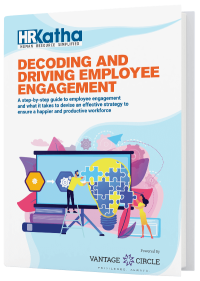5 Powerful Employee Engagement Models That Leaders Should Know

Any good leader, worth their salt, would know that today’s workforce seeks more than just an excellent salary. People want to work at places where their contributions are seen, valued, and recognized. For leaders looking to engage their people, it’s essential to utilize the research already available to you. This is where the need for employee engagement models comes in.
Investing in your people is the central idea behind employee engagement. If your people are happy and satisfied, chances are they will go above and beyond for every piece of work they do.
Similarly, demotivated employees are bad news for any business. For any leader, it is vital to ensure that any source of employee discontent is promptly taken care of.
The engagement level of an employee can be classified in three main ways:
- Actively Engaged
- Not Engaged
- Actively Disengaged
Fortunately, you are not alone in your endeavors. For the last decade, numerous industry-based research has highlighted the need for engagement.
Along with these advances, comprehensive studies have been carried out to create actionable employee engagement models to make engaging people easier.
But wait. What exactly do we mean by employee engagement models?
An employee engagement model depicts the roadmap of how to make an employee feel happy, empowered, and productive at work.
Years of testing and detailed studies by industry experts have gone into the development of these models.
This makes it an excellent place to start for companies looking to get more involved in engaging their people.
This article will focus on the five crucial employee engagement models that every leader should know about.
5 Powerful Employee Engagement Models That Boost Productivity
Aon Hewitt Engagement Model
Aon Hewitt is one of the world’s leading consultants on human capital management.
Thus, it’s safe to say that their ideas and study of employee engagement will impact any company looking to make their people feel happy and satisfied.
Aon Hewitt’s employee engagement model can be summarized as below:
These are the areas over which management has a great deal of control—the action areas.
The extensive research done by Aon Hewitt formed the six major categories of employee experience, namely- the work people do, the people they work with, opportunities, total rewards, company practices, and general quality of life.
According to Aon Hewitt, the process of engaging people is influenced by six major engagement drivers.
Work
The job that people do should align with their vision and add value to their lives. Therefore, it includes aspects such as:
- Employee empowerment and autonomy
- Sense of achievement
- Work tasks
People
An employees’ work-life involves connecting with a diverse set of people. It may include:
- Employee-employer relationships
- Supervision
- Collaboration
Quality Of Life
The quality of work-life consists of factors such as:
- Job security
- Safety
- Work-life balance
Company Practices
The company-wide practices and policies hugely affect the overall level of engagement.
- Diversity and inclusion
- Communication
- Innovation
- Talent and staffing
- Performance management
Total Rewards
Employee appreciationhas a profound impact on workers’ sense of value and identity. Thus, we should prioritize the following factors:
- Recognition
- Rewards
- Pay
- Compensation/Benefits
Opportunities
The opportunity to grow personally and professionally is vital to engagement.
- Learning opportunities
- Career opportunities
- Training
- Promotions
According to Aon Hewitt, higher levels of engagement will reflect the following results:
Say: Engaged employees speak positively about the company to peers, potential employees, and customers.
Stay: Engaged employees feel proud to work at a particular company with no intention of leaving.
Strive: Engaged employees go above and beyond to contribute to business success.
Zinger Model of Employee Engagement
David Zinger, a well-known global management consultant, introduced the Zinger Model of Employee Engagement.
With over 25 years of experience in this field, Zinger’s work focuses on improving employee engagement by building meaningful workplace relationships.
And that does make sense. After all, wouldn’t you like to work at a place that values and appreciates you?
The David Zinger model illustrates the modern workplace’s various features, including employee experience, motivation, and commitment. In addition, the Zinger model provides leaders with 14 critical strategies that have the potential to enhance the employee experience. Let’s have a look at these factors:
1. Achieve Results
The ultimate aim of the Zinger Model is to reach higher levels of employee engagement in an organization. As a leader, the key questions to consider are:
- What do you hope to achieve?
- How will you know once you achieve it?
2. Craft Strategies
The first and foremost challenge to getting any result is to develop the right effective strategies. Before forming any strategy or plan, leaders should consider the following aspects:
- How will we get those results?
- Does everyone know the organization’s intentions and goals?
- Is our strategy engaging?
- Will there be adequate employee involvement to carry out the strategy?
3. Connect
When employees feel engaged, a large part is attributed to their connection to their peers and the work environment. Therefore, it wouldn’t be wrong to say that connection is synonymous with engagement.
4. Authentic
The manner of engaging your people should be authentic at best. Powerful engagement is driven by genuine, heartfelt, and meaningful actions. If your people feel like your efforts are just a corporate exercise, engagement will never happen.
5. Recognition
Meaningful rewards and recognition drive powerful engagement. Timely, frequent, and value-based recognition will truly elevate your employee experience to the next level.
6. Engage
“Engage” denotes the actions that drive engagement. To engage people, leaders must go beyond a stale one-time recognition effort. Instead, these actions should be dynamic, team-based, and continuous.
7. Enliven Work Roles
The roles of a worker hugely influence their work-life and its balance. Therefore, while the position should provide some level of competition, it should not overwhelm people.
8. Excel At Performance
Engagement heightens performance. Higher performance indicates engagement. Thus, it’s necessary to deliver an employee experience that enables people to do meaningful work.
9. Esteem Organization
The first indicator of disengagement is when your people don’t feel proud to work at your company. Some crucial pointer to look out for are:
- Are your people aligned with the company values?
- Do employees feel valued and feel like they are a part of the company?
- Are your people recommending your company to their friends and family?
- Do your people publicly advocate for the company?
10. Foster Community
A work environment that focuses on fostering good, positive, and long-term connections between people is vital to engage a workforce fully.
11. Serve Customers
To provide a seamless customer service experience, it’s important to note that motivated workers are more likely to succeed in these endeavors. In addition, happy employees are more likely to be available, helpful, and attentive to customer satisfaction.
12. Develop Career
To make your people feel 100% invested in their work, it’s essential not to overlook their personal development. Assure that your employees get the proper training and development opportunities to grow in their careers.
13. Leverage Energies
Employee engagement is a marathon and not a sprint. Ask yourself: Do we have enough energy to engage our people in the long run fully? Unless that happens, your turnover rates will see a spike once you stop the engagement measures.
14. Experience Wellbeing
The crucial part of any employee engagement measure is that it makes the employee feel good about themselves. People who are at their peak of health and happiness will be more productive in the long run.
Gallup Employee Engagement Model
It is a well-known fact that the best tool for measuring engagement is an employee survey (preferably pulse surveys). For several years, Gallup- the workplace analytics giant- was involved in answering the question that haunts every corporate.
How to measure employee engagement accurately?
After several years of a study spanning over millions of participants, hundreds of countries, and multiple languages- Gallup came up with an employee engagement model known as the Q12 Pyramid. And it worked.
The Q12 Pyramid quickly proved to be the gold standard in differentiating a productive work environment from a non-productive one.
The Q12 is not your typical engagement model. The Q12 is, in reality, 12 key questions that are used to track overall employee sentiment. These survey questions are pivotal in assessing how engaged, disengaged, or neutral your people are.
These Q12 questions are illustrated below:
- Do you know what is expected of you at work?
- Do you have the materials and equipment to do your work right?
- At work, do you have the opportunity to do what you do best every day?
- In the last seven days, have you received recognition or praise for doing good work?
- Does your supervisor or someone at work seem to care about you as a person?
- Is there someone at work who encourages your development?
- At work, do your opinions seem to count?
- Does the mission/purpose of your company make you feel your job is important?
- Are your associates (fellow employees) committed to doing quality work?
- Do you have a best friend at work?
- In the last six months, has someone at work talked to you about your progress?
- In the previous year, did you have the opportunities to grow and learn?
Schmidt Model of Employee Engagement
The Schmidt model, developed in 2004, places value on attracting and retaining people who would fit the culture and its people.
The model considers that if a business recruits the right people with the right expertise and competencies, the work environment becomes more positive.
Thus, people are more likely to feel committed and do meaningful work as a result.
International Survey Research Approach Model
The ISR model was developed in 2003 by using survey data from 3,60,000 employees and more from 41 companies worldwide. The ISR Model’s approach to measuring employee engagement focuses on three major components, namely:
- Cognitive (Think)
- Affective (Feel)
- Behavioural (Act)
According to ISR, the act of engaging people has three levels:
Cognitive (Think): When an employee believes in the company’s mission, values, and goals. It influences a sense of belonging and makes a person feel proud to work at a company.
Affective (Feel): It ensures that workers feel pride in their association with the company. This aspect is strongly related to corporate loyalty.
Behavioral (Act): It depicts the actions, beliefs, and feelings that an engaged employee feels towards the organization.
Companies should explore these three elements in detail to establish relevant and practical strategies for boosting engagement.
To Conclude
As a leader, which employee engagement model will you be focusing on more? Let us know your feedback and opinions in the comments section below.

Vantage Circle is a simple AI-powered Rewards & Recognition Platform for upgrading your employee experience and engagement for better productivity.






